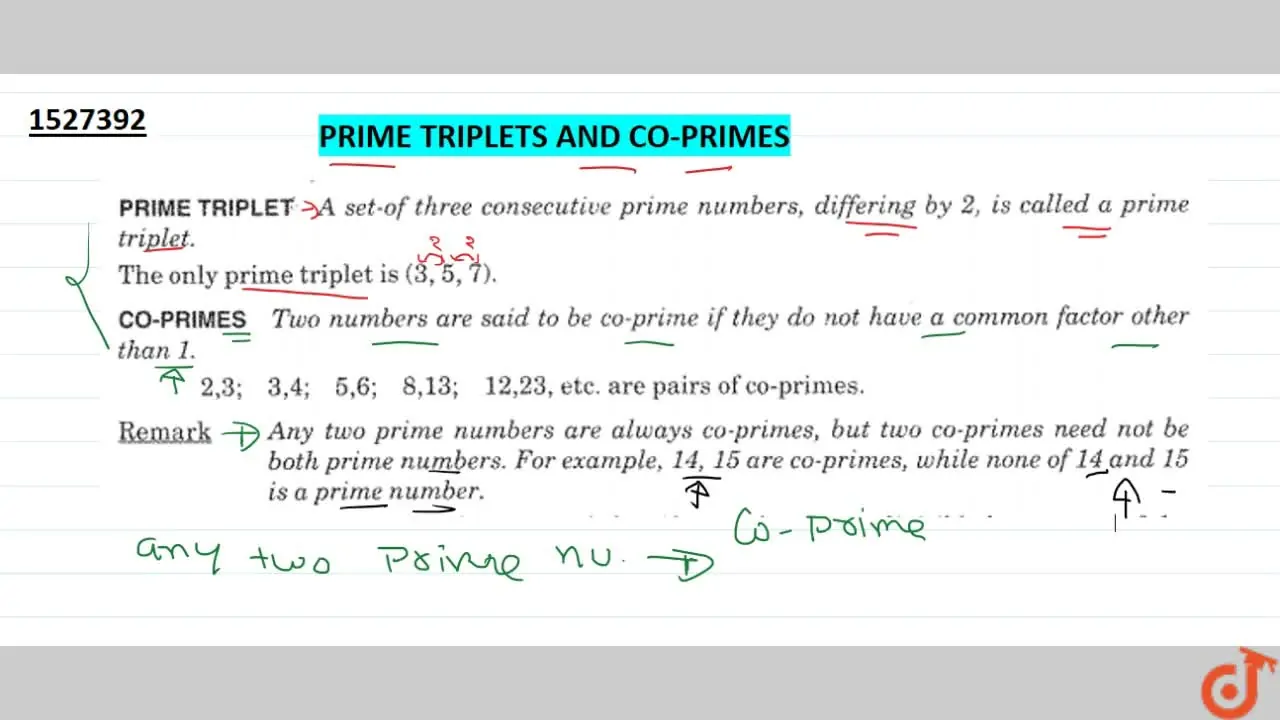Co-primes
Co-Primes
This chapter deals with the understanding of co-primes. We will try to gather all information on co-primes numbers, how to find co-prime numbers, and so on. We will all look at some of the co-primes examples that would help in understanding it better.
What are Co-Prime Numbers?
The set of integers or numbers that has only 1 as their common factor (HCF will be 1) are known as Co-Prime numbers. They are also known as mutually prime or relatively prime numbers. It is very important to note that to form co-primes, there should be two numbers.
How to find Co-Prime numbers?
Let us consider a set of two numbers. The pair of numbers are co-prime in case there are no positive integers that can divide both, other than 1. We will try to understand with the help of an example. Suppose we take two numbers, 21 and 22. We can find that the factors of 21 are 1, 3, 7 and 21. On the other hand, coming to the factors of 22, they are 1, 2, 11 and 22. So, in this case, we can see that the common factor of 21 and 22 is 1. So, their HCF is 1, which is a co-prime number. Again, if we take the numbers 21 and 27, we can find that the factors of 21 are 1, 3, 7 and 21 while the factors of 227 are 1, 3, 9 and 27. In this case, 1 is a common factor of 21 and 27. But they are not co-prime because of the reason their HCF is 3.
Properties of Co-Prime Numbers
We will now look at the properties of Co-Prime numbers as under:
- 1 is co-prime with all other numbers.
- Any two integers or consecutive numbers are always found to be co-prime. If you select any consecutive numbers like 3, 4 or 5,6 or 7, 8, etc., their HCF will be 1
- All prime numbers are co-prime to each other. This is because there are two factors 1 and the number itself when it comes to every prime number. At the same time, 1 is the only common factor of two prime numbers. We can take, for example, numbers 2 and 3, which are two prime numbers. Here 1 and 2 are the factors of 2, while 1 and 3 are the factors of 3. So, 1 is the only common factors for which it is a co-prime.
- When it comes to the product, the sum of any two co-prime numbers are always co-prime. If we take for an example of number s 2 and 3. They have 5 as their sum (i.e., 2 + 3 ) and are co-prime. On the other hand, as a product, they are 6 (i. e . 2 x 3). So, it can be concluded that both the numbers 5 and 6 are co-prime to each other.
Related Videos:
We will work on some problems which would help to clear your doubts in the best way.
Question: Determine whether the numbers 13 and 31 are co-prime or not?
Solution: We see that both the numbers are prime when it comes to 13 and 31. So, we can say that they are co-prime to each other.
Now, when we look at the factors of 13, they are 1 and 13.
By looking at the factors of 31, we find 1 and 31.
Since they have 1 as their common factor, hence they are co-prime numbers.
Question: Calculate how many integers from 101 to 300 are co-prime to 20?
Solution: Here, 20= 22 x 5
It is important to find the numbers which do not have 2 or 5 as factors.
Numbers which are multiple of 2 between 101 to 300 = 200/2 = 100
Numbers which are multiple of 5 between 101 to 300 = 200/5 = 40
Next we have to find numbers which are multiples of both 2 and 5
Numbers which are multiple of 10 (both 2 and 5) between 101 and 300 = 200/10 = 20
So, we get the total = 200 – (100 + 40 – 20) = 200 – 120 = 80
Therefore, the answer is 80.
Question: Calculate how many positive integers between 100 and 200 are co-prime to 630?
Solution: Here, 630 = 2 * 32 * 5 * 7
Numbers which are divisible by 2 between 100 and 200 = 51
Numbers which are divisible by 3 between 100 and 200 = 33
Numbers which are divisible by 5 between 100 and 200 = 21
Numbers which are divisible by 7 between 100 and 200 = 14
Total = 119
Next, we have to find out the double counting cases and then remove them.
So, the numbers between 100 and 200 which are divisible
by 2 * 3 = 17
by 2 * 5 = 11
by 2 * 7 = 7
by 3 * 5 = 7
by 3 * 7 = 5
by 5 * 7 = 3
by 2 * 3 * 5 = 3
by 3 * 5 * 7 = 1
by 2 * 5 * 7 = 1
by 2 * 3 * 7 = 2
by 2 * 3 * 5 * 7 = 0
So, the total (to be removed) = 50 – 7 = 43
Therefore, positive integers which are co-prime to 630 between 100 and 200 = 101 – (119 – 43) = 25
Therefore, the answer is 25.
Question: Calculate how many three-digit numbers less than 200 are co-prime to 638?
Solution: 638 =2 * 11 * 29
3 digit numbers divisible by 2 less than 200 = 50
3 digit numbers divisible by 11 less than 200 = 9
3 digit numbers divisible by 29 less than 200 =3
So, total= 62
Now on taking pairs:
3 digit numbers divisible by 2*11 less than 200 =5
3 digit numbers divisible by 2*29 less than 200 =2
3 digit numbers 11*29less than 200 divisible by =0
Therefore, the answer is 100- (62-7) = 45
Important Chapters:
Numbers which are multiple of 2 between 101 to 300 = 200/2 = 100
Numbers which are multiple of 5 between 101 to 300 = 200/5 = 40
Numbers which are multiple of 10 (both 2 and 5) between 101 and 300 = 200/10 = 20
Therefore, the answer is 80.
Numbers which are divisible by 3 between 100 and 200 = 33
Numbers which are divisible by 5 between 100 and 200 = 21
Numbers which are divisible by 7 between 100 and 200 = 14
Total = 119
by 2 * 3 = 17
by 2 * 5 = 11
by 2 * 7 = 7
by 3 * 5 = 7
by 3 * 7 = 5
by 5 * 7 = 3
by 2 * 3 * 5 = 3
by 3 * 5 * 7 = 1
by 2 * 5 * 7 = 1
by 2 * 3 * 7 = 2
by 2 * 3 * 5 * 7 = 0
So, the total (to be removed) = 50 – 7 = 43
3 digit numbers divisible by 11 less than 200 = 9
3 digit numbers divisible by 29 less than 200 =3
3 digit numbers divisible by 2*29 less than 200 =2
3 digit numbers 11*29less than 200 divisible by =0
Similar Questions
Co-prime numbers is a set of numbers which have 1 as their .......................
View SolutionCo-prime numbers is a set of numbers which have 1 as their .........
View SolutionThe value of log59⋅log75⋅log37log3√6+1log4√6 is co-prime with
View SolutionCo-Prime Numbers and Twine Prime Numbers
View SolutionWhich of the following pairs is co-prime?
View SolutionThe LCM of two co-prime numbers is their .
View SolutionWhich of the following is a co-prime with 273
View SolutionHCF of two co-prime numbers is:
View Solutionif a and b are two odd distinct prime numbers and if a > b then a2−b2 can never be divided by :
View SolutionIdentify the Co-Prime pair from the given options
View Solution


